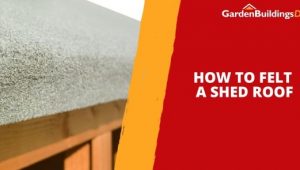Jump to:
Shed condensation occurs when there’s too much humidity in your garden storage building. Wood and metal sheds, in particular, are affected by this.
Timber is naturally porous, meaning it absorbs moisture from the air. Metal is susceptible to rust, especially when moisture builds up on the surfaces. This guide explains the causes further and offers the best ways to tackle them before they get out of hand.
Poor Ventilation: A Key Cause of Shed Condensation
When air can’t circulate, moisture from the ground can accumulate. That trapped humidity settles on the coldest surfaces first. Starting on the walls, roof panels, or any metal fittings, then turns into condensation.
Let fresh air in—swing the doors and/or windows open each morning, and if it’s dry later on, give them another opening. Even a few minutes does wonders. If you only nip into the shed now and then, leave the door a bit ajar when you’re not inside, and fit a latch or hook so it stays put.
If that isn’t an option, install vents. You can buy clip‑in vents under £10 and slot them into the walls or roof panels without fuss. A small, low‑wattage fan will help keep air moving for larger or more frequently used sheds.
Make it a habit to regularly air your shed to keep humidity levels down and stop moisture. This will also stop rot, rust and mould in their tracks!
Condensation Comes from Wet Items
After a wet spell, your shed can end up with all sorts of damp stuff. Muddy wellies, soggy jackets or even a toolbox, for instance, with some water still inside. The easiest fix is to empty it out on a dry, mild day, so you can spot what is wet.
If you spot any wet patches on the floor or walls, wipe them with an old towel. Try to keep your stuff off the ground, too. Chuck it on a shelf or hang it up if you can—that way, air can move around and things don’t stay damp.
If the floor itself is damp, it may indicate rising damp or water ingress from poor ground preparation or lack of a damp-proof membrane (DPM). This is particularly important for wooden sheds.
And if you see any signs of mice or something nesting, best to sort it sooner rather than later. Call pest control if you need to, or set a trap yourself if you’re comfortable doing that.
Use a Dehumidifier to Stop Condensation and Mould
Is your shed still getting condensation even after airing it out and clearing the wet bits? If yes, it might be time to try a dehumidifier. It’s most effective if you use the space as a gym shed or somewhere you’re regularly in and out.
A small, portable dehumidifier should be used for a standard wooden shed. It helps pull moisture, especially in colder months. You’ll be surprised how much water they can pull from the air, even when it doesn’t feel particularly damp.
Shed Insulation Helps Prevent Condensation
Installing insulation in your shed helps keep the temperature stable and cuts down sudden changes that lead to moisture issues. However, this is a modification that is undertaken at your own risk.
Foam board insulation is easy to fit and does a good job of keeping heat in and cold out. You can also use reflective foil to keep heat in and stop the cold from getting through. Both are easy enough to fit and don’t take much doing, and are suitable for wooden and metal sheds.
How to Stop Mould in a Shed
Condensation can quickly become mould if left unchecked. As such, the ways to prevent mould are the same ways we prevent the condensation:
Improve ventilation – Install shed vents or leave the door ajar when possible. Good airflow prevents damp, which feeds mould.
Check for leaks – Inspect the roof, windows, and base for water ingress. Fix any gaps or cracks with waterproof sealant.
Use a moisture absorber or dehumidifier – These pull excess moisture from the air and reduce the risk of mould spores taking hold.
Insulate your shed – Stable temperatures help prevent condensation and mould growth. Use foil or foam board insulation.
How to Clean Mould Off a Shed
Let’s say the mould has already started to grow in your shed. This is a major problem for wooden sheds in particular, as it eventually affects the integrity of the timber.
You’ll want an effective mould remover. For wooden sheds, we’d recommend white vinegar rather than a bleach-based mould remover. This is for a few reasons:
Bleach only kills surface mould on wood; it doesn’t penetrate into the fibres.
Mould roots (hyphae) stay inside the wood.
Bleach is water-based, and the moisture can actually feed mould in porous materials (like shed timber).
Use bleach and bleach-based mould killers only on:
Non-porous surfaces (plastic, metal, glass)
Painted or sealed wood — not raw wood
- Vinegar penetrates the porous surface of wood and kills mould at the root.
If the mould is starting to seep into the wood, here’s the method to get rid of it.
- Mix undiluted white vinegar in a spray bottle.
- Spray directly onto the mouldy wood.
- Let it sit for at least 1 hour.
- Scrub with a stiff brush or cloth.
- Wipe clean with water and let it dry completely.
- Repeat as needed.
Round-up
Condensation doesn’t have to be a constant issue. With proper ventilation and clearing out the damp, you can keep your shed much drier. Insulation or a dehumidifier will also help prevent bigger problems down the road.
Keep an eye on the weather, too. If it’s been wet or cold, try airing the shed out more often and check your gear for dampness. Once you get into these simple habits, managing condensation gets much easier.
Here’s your next read to learn more tips: How to Tackle Condensation in Your Metal Garden Shed





